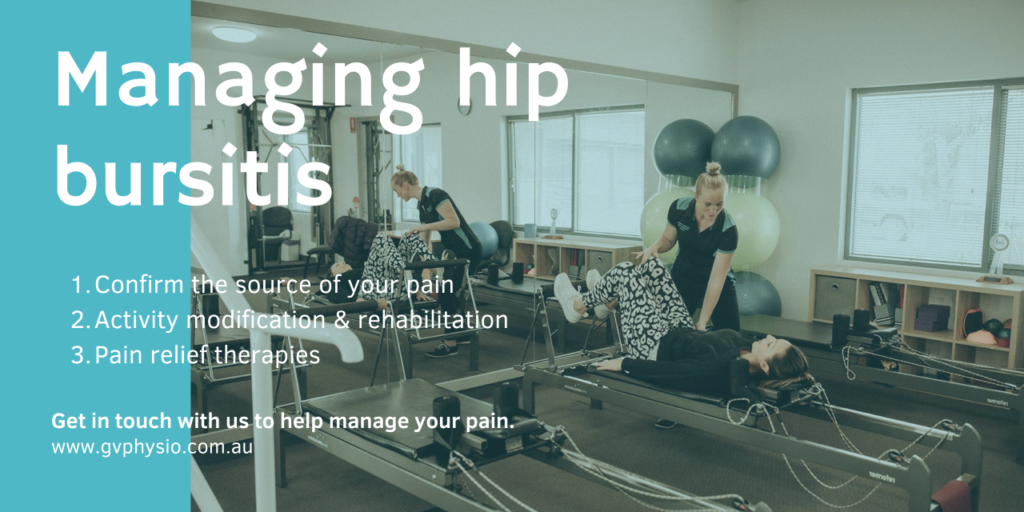Trochanteric bursitis, or hip bursitis, is a frequent cause of pain to the side of the hip. Put basically bursitis is the inflammation of a bursa which can occur for a variety of different reasons and in all different types of people. But what do I do about the pain?
A common misconception is that the inflamed bursa should not be there and therefore needs to be removed. Bursitis of the hip can be anywhere from mild discomfort to severe and debilitating pain. It is one of the most common hip pain related reasons for referral to orthopaedic surgeons, despite rarely being operated on, with gold standard care being conservative management. Such management can include but is not limited to; physiotherapy, consultation with your GP to discuss appropriate pain management intervention such as anti-inflammatory medication where appropriate and in some cases cortisone injection.
It is also common to have other structures nearby contribute to hip pain, be equally as painful, and sometimes, more painful than the bursitis itself. Structures such as the gluteus medius, and gluteus minimus often contribute to symptoms. The Iliotibial band also has an influence around pain on the outside of the hip. Being physically assessed can help to pin point which structures might be contributing most to your hip pain. But back to that bursa.
So, what is a bursa?
A bursa is a small fluid filled sac that acts as a little cushion for the soft tissues around the lateral aspect of the hip. It helps to lubricate the bony part of the outer hip to allow tendons, particularly the gluteus tendons, to continue to move freely while the body is in motion. We have these bursas all around the body to ensure that tendons and muscles function smoothly and with little irritation caused by interaction with bony areas of the body.
So, why is this hip bursa so sore?
The trochanteric bursa can become inflamed and painful as a result of altered movement patterns, frequent compression through certain postures, or in few cases for no apparent reason at all.
Unfortunately, women are twice as likely to suffer from hip bursitis compared with men due to biomechanical differences that see women generally with a greater femoral angle compared with men. This angle creates additional compressive forces through the outside of the hip. Combine this with hormonal changes experienced around this time, and cases of deconditioning through the lumbopelvic region, women through their 40s to 70s are our most frequent hip bursitis patients.
Men and women later in life who find themselves spending more time sitting throughout the day provide the bursa with a constant compressive force at rest. When combined with a reduction in general fitness and muscle strength through the hip and pelvic region both men and women over the age of 80 susceptible to experiencing an inflamed trochanteric bursa.
But it’s not just ‘middle-aged’ women and our older Australian’s experiencing this turmoil. Young female athletes make up the third most frequent sufferers of hip bursitis with heavy and frequent training loads combined with ongoing development through the hip and pelvic region making for a painful hip in some instances. Most commonly high load walking and running activities or activities that involve a repetitive use of the hip joint and muscles can contribute to lateral hip pain in young females.
So, over-activity, under-activity, biomechanics and stage of life are strong contributors to the development of bursitis. Some components are controllable while others are not. So how do I manage my hip bursitis?

The ‘gold-standard’ is to manage conservatively through means of physiotherapy combined with pain management medications prescribed or recommended by your GP. Your physiotherapist will assess the lumbopelvic region for biomechanical and strength related limitations and use these findings to:
– develop an appropriate conditioning program
– educate you on how best to modify or adjust your current daily practices to reduce the ongoing irritations to the lateral hip region
– provide manual therapies as appropriate to assist in reducing pain.
In some cases where the inflammation and pain are severe, a steroid injection may be used to specifically target the inflamed bursa. This approach together with conservative measures that your physiotherapist will assist you with not only helps to address the current acute bout of pain but provides you with the formula to reduce the likelihood of future occurrences to provide more sustainable and long term management.
Our team of physiotherapists are expertly trained in assessing, education and re-conditioning clients who are experiencing this type of hip pain.

Written by
Emily Ryan
Emily graduated with a Bachelor of Exercise Science and Masters of Physiotherapy Practice and has been working with our team of Physiotherapists since 2018.
References
Seidman AJ, Varacallo M. Trochanteric Bursitis. [Updated 2021 Jul 18]. In: StatPearls [Internet]. Treasure Island (FL): StatPearls Publishing; 2021 Jan-. Available from:
https://www.ncbi.nlm.nih.gov/books/NBK538503/
Le DT, Shah S. Greater Trochanteric Bursitis Injection. [Updated 2021 Aug 7]. In: StatPearls [Internet]. Treasure Island (FL): StatPearls Publishing; 2021 Jan-. Available from:
https://www.ncbi.nlm.nih.gov/books/NBK573083/

